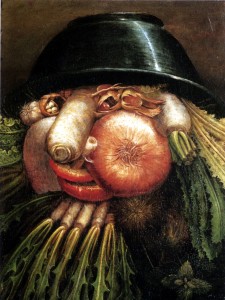The “Organization” of Law (Part 2)
By Asher Crispe: March 26, 2014: Category Inspirations, Quilt of Translations
 The embodiment of the law mirrors the saga of the human somatic experience. Just as the renaissance artist Giuseppe Arcimboldo (1526-1593) paints human figures out of common objects such as books, fruits, trees, animals and the like, so too Jewish mystical literature composes a human being out of laws and laws in the shape of a human being. Perhaps more hyperbolically, when we perform a commandment of the King (Divinity), we not only fix a limb of our own embodiment, but we also accomplish the same thing for the metaphysical ‘body’ of the King, in that the Zohar (III 113a) contends that ‘God performs the same commandment as it were Above’ in concert with what we did below. Essentially, we have anthropomorphized the law.
The embodiment of the law mirrors the saga of the human somatic experience. Just as the renaissance artist Giuseppe Arcimboldo (1526-1593) paints human figures out of common objects such as books, fruits, trees, animals and the like, so too Jewish mystical literature composes a human being out of laws and laws in the shape of a human being. Perhaps more hyperbolically, when we perform a commandment of the King (Divinity), we not only fix a limb of our own embodiment, but we also accomplish the same thing for the metaphysical ‘body’ of the King, in that the Zohar (III 113a) contends that ‘God performs the same commandment as it were Above’ in concert with what we did below. Essentially, we have anthropomorphized the law.
The ‘embodiment’ of Divinity [which can never be taken literally for the Divine has neither a physical body nor corporal properties–rather, this use of language is but a trope] occurs with the clustering and congealing of Torah text into the enactments specific of each ‘organ.’ Our ‘organizational’ efforts do not merely keep the organs in good health, nor do they simply take inventory of the parts of some larger whole, rather, they continuously regenerate the real limbs from the program of their theoretical ‘phantom’ counterparts. We effectively situate ourselves within a legal framework of our own making that ends up defining us by our actions.
For the mannerist aesthetic of Arcimboldo, any set of items of interest may be self-styled into a familiar form if only the constellation of objects are placed in the proper perspective. Amassed out of a careful arrangement of common ‘things,’ we begin to apprehend ourselves within them. All figures are configured. We are made out of a pattern collected from the world around us. Given this parallelism, might we not gain a great deal of insight from exploring the most basic organizational structure that produces a host of differences–namely our gendered bodies? Would this not be akin to saying that there are masculine and feminine components to law which are each assigned a different set of organs or complementary organizational principles?
Deep down, are we not all androgynous? The story of the primordial human condition which addresses the primacy of our experience of ourselves, transports us back to an initial setting when the lived body contained within it both masculine and feminine states. Every time we revisit the Edenic depiction of humanity, we should be reminded that initially “male and female He created them” (Genesis 1:27). According to the Midrash, this phrase supports the idea of foundational gender dimorphism within a single composite body. Only later does the separation occur whereby both male and female gain a unique corporeal encasement specific to each of them (Genesis 2:21-22). However, this first surgical procedure in the Torah may be understood as a fundamental type of analysis whereby we bifurcate a previously nebulous and undifferentiated gendered state into specific gender roles.
The lesson in all of this which can be carried forward requires us to inflect all of these descriptions into the arena of consciousness. We are really learning about developmental procedures in the human psyche. Consequently, in the origins of any experience, our masculine and feminine sensibilities are entangled and housed together but, as we reflect further, we begin to pull them apart and think of them as two distinct facets of consciousness. In making such a move, we are once again following the strategy of the kabbalists who often times decouple concepts of the masculine and feminine from the biological male and female. What then do they represent here? In a word–polarization. Our universe is filled with things that have an attractive force moving us forward and a repulsive force holding us back, a projecting and injecting, a positive and a negative.
The problem has always been that we have had a tendency to unfairly weigh the masculine at the expense of the feminine throughout much of the course of history. Itself a symptom of exile, the failure to value the feminine and its associate qualities dislocates the proper relationship between this gender pair. Moreover, the restoration is not accomplished by simply standing them side by side, but by marrying them–that is, by synthesis or interinclusion. Subsequently, the positive may be detected within the negative and the negative within the positive. One might say that there is something profoundly positive–maybe even the surplus of the positive–in the negative. To employ a similar formulation, we might alternatively say that there is the feminine within the feminine and the masculine within the feminine, just as there is the masculine within the masculine and the feminine within the masculine. But all of this is merely a conceptual backbone for our real topic: the body of law.
In their mystical distillation, the performatives (mitzvot) of the Torah come in two forms. The positive commandments (‘thou shall…’) and the negative commandments (thou shall not…). If I am putting myself out there, projecting and asserting myself in the world and onto objective reality, then I am in the masculine mode of being (even if I happen to be biologically female). Likewise, if I am refraining from acting, holding myself back, withdrawing from a prohibited activity or a morally and spiritual adverse situation, I may think of myself as positively bringing about the absence of something. This inaction is for me a feminine mode of being (even if I happen to be biologically male). Furthermore, one must work at refraining from something. Inaction is itself an action of sort which implies a great degree of self-control. Obviously in life both modalities are needed. They should even optimally be well integrated (married) into the cybernetics of my executive decisions.
In kabbalistic discourse, we often equate the feminine and masculine with the fundamental pulsation of every soul. Termed a ‘run and return’ phenomenon (ratzo v’shuv), the energetic alternating current that flows through me at once launches me out of myself in search of transcendence and simultaneously lures me in as I am called back to nest. Technically speaking, the insufficient containment capacity of all vessels (body included) to grasp and express my core being, ratchets up the inner tension that catapults me into a beyond.
 My thirst is to drown in the infinite as a pure light divested of the shell of the body. It is yearning for complete fusion–the dissolving of the self back into our source within Divinity. And yet, this is not the end game in Judaism. Rather, it marks the moment of inspiration which cannot breathe for very long in the upper atmosphere. Therefore, after flying high and taking in the boundless freedom and wonderment, gravity begins to reassert itself and I start to feel the pull of the earth and the call of home. True life still lies below. Reenergized, I must bring back the awakened awe of the experience and attempt to infuse it within the pathways and rooms of my mundane affairs.
My thirst is to drown in the infinite as a pure light divested of the shell of the body. It is yearning for complete fusion–the dissolving of the self back into our source within Divinity. And yet, this is not the end game in Judaism. Rather, it marks the moment of inspiration which cannot breathe for very long in the upper atmosphere. Therefore, after flying high and taking in the boundless freedom and wonderment, gravity begins to reassert itself and I start to feel the pull of the earth and the call of home. True life still lies below. Reenergized, I must bring back the awakened awe of the experience and attempt to infuse it within the pathways and rooms of my mundane affairs.
While our ‘run’ suggests a repudiation of specific actions under certain circumstances (refusal to participate in theft and murder for instance), it is the ‘return’ which secures a worthy investiture of myself in sanctioned activities (as in the performance of positive commandments such as loving one’s neighbor). If I can lose myself in doing what I shouldn’t, then it stands to reason that I can recover myself by eschewing that same thing. Hence, the self is the by-product of the relationship between what I am not and what I am.
From the gendered body to the engendered body–our exploration continues in Part Three.
http://www.interinclusion.org/inspirations/the-organization-of-law-part-3/
http://www.interinclusion.org/inspirations/the-organization-of-law-part-1/
The “Organization” of Law (Part 2),
















;)
;)
;)
;)
;)
;)
;)
;)
;)
;)
